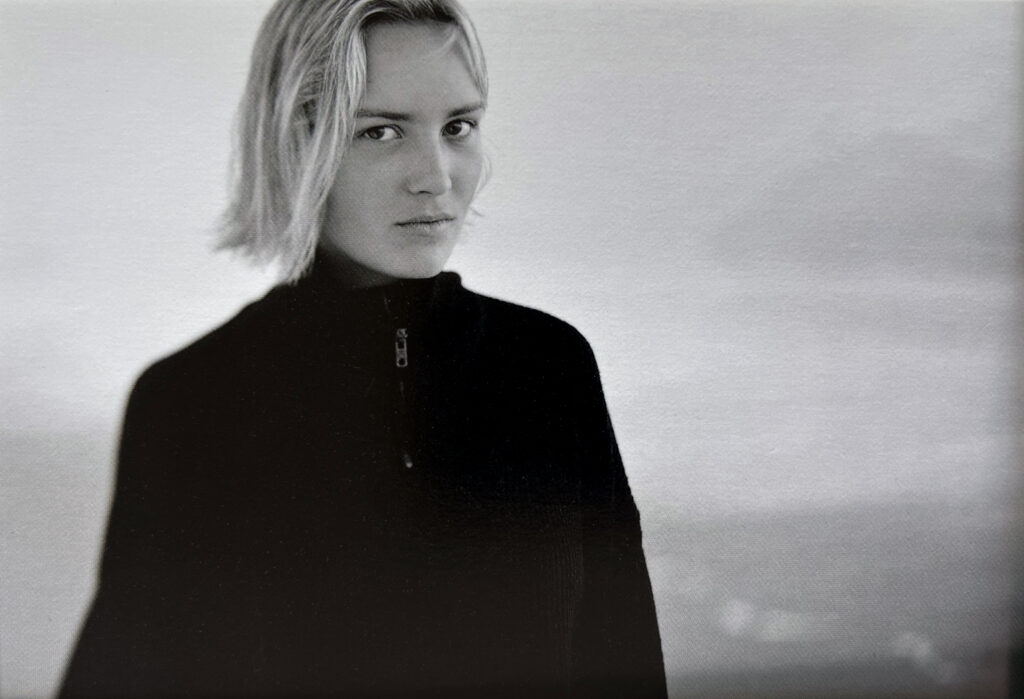
“Sara, Montalivet, France (1998)” by Jock Sturges. This small 5″ x 7″ gallery show card was added to The Michael Aaron Gallagher Fine Art Collection in 2021. It is a postcard for the artist’s opening reception on April 1, 1999 at the Butters Gallery in Portland, Oregon. The subtle nuances of her microexpressions and body language give this photograph a particularly mysterious emotional quality in what would otherwise be a blank stare.
With the goal of building a museum-worthy art collection that celebrates “beauty above all else,” The Michael Aaron Gallagher Fine Art Collection’s Jock Sturges Photography Exhibit showcases 17 stellar black and white prints signed by the famed photographer. They include limited edition 16″ x 20″ prints, a rare gelatin silver artist’s proof, as well as an 11″ x 14″ archival ink print, which was purchased to support the work of the Photographic Center Northwest in Seattle, Washington.
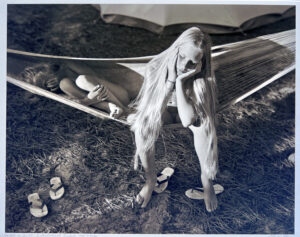
“Nikki and Lotte, Montalivet, France (1993)” by Jock Sturges. This limited edition 11″ x 14″ archival pigment ink print was purchased to support the work of the Photographic Center Northwest in Seattle, Washington.
Although Jock Sturges‘ photography continues to be the subject of criticism for some unsophisticated viewers, his work remains iconic and timeless within the art world. His prints are held in the permanent collections of prestigious museums and art galleries around the world, including The Museum of Modern Art in New York City, The Metropolitan Museum in New York City, the Bibliothèque Nationale in Paris, The Frankfurt Museum of Modern Art in Germany, and the Museum of Contemporary Photography in Chicago. His work as a world-renowned photographer continues to inspire the next generation of visual artists who aspire to achieve what he has with the 8×10 camera.
Born in New York City in 1947, Sturges studied photography at Marlboro College and the San Francisco Art Institute. His ethereal images have been published in several books, including The Last Day of Summer (1992), Radiant Identities (1994), Evolutions of Grace (1994) and Fanny (2014).
The Collection and Art Memorabilia
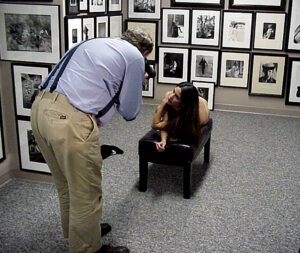
Photographer Jock Sturges takes a picture of a model at the Levin Gallery. Photo courtesy of Russell Levin.
Accompanying the art in The Collection is a brochure for his exhibition celebrating the launch of his book Fanny published by Steidl, 12 framed gallery invitation show cards from Butters Gallery in Portland, Oregon that span the years 1991-2010 with small photographs on the front, postcards featuring Jock Sturges photographs from Galerie Bodo Niemann in Berlin, Germany, and a personal letter from the photographer about his work. Related photography memorabilia included in the exhibit are three framed CDs by the band Ride, which feature Jock Sturges photographs on the cover of the albums. The cover of the CD “Leave Them All Behind” has a photograph of Misty Dawn, the cover of “Grasshopper” is a portrait of Lidiwine from 1988 and “Twisterella” features the 1985 photograph titled, “Christina, Misty Dawn and Alysa, Northen California.” The models whose photographs are currently in the print collection are Fanny, Vanessa, Rita, Adèle, Celie, Lidiwine, Nikki, Lotte, Catherine, Angela, Lauralee, Alexandra, Sonja, Claire, Isabelle, Ferry, Myriam, Ilka, Cindy, Kelly and Hanneke.
Many of the models who posed for Jock Sturges pictures continued to do so for decades, chronicling their changing beauty from youth through adulthood. His photographs possess both an artistic quality to them, while also documenting specific moments in time. The Collection features two beautiful examples of his models growing older and changing over time, while demonstrating the same ability to create powerfully unique pictures.
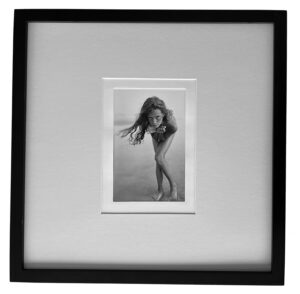
This small framed postcard (3.5″ x 5.5″) from Galerie Bodo Niemann in Berlin, Germany is of one of Jock Sturges’ most iconic photographs of Fanny, which was taken on the beach in Montalivet, France in 1995 and appears on page 33 of his photography book titled “Fanny.” Her powerful stare and the dramatic angles of her posture make this one of Jock’s best photographs of Fanny. The postcard was acquired from the Russell Levin Gallery in Monterey, California and added to The Michael Aaron Gallagher Fine Art Collection in 2025.
Perhaps the best example of this evolution of expressions is in three consecutive 16″ x 20″ gelatin silver photographs of Fanny, taken on the beach in Montalivet, France in 1995, 1996, and 1997. In the forward of his photography book titled, Fanny, Jock Sturges writes about the middle picture, which appears on page 37 in the book and was taken in 1996, a year after her mother’s tragic passing. “You see her standing with one hand flagged out to the side and the other clenched in a fist,” he wrote. “Her mother would often flag a hand like this, so I see her in this hand and the pain of her passing in the other.” As the first and undoubtedly the most powerful Jock Sturges photograph added to The Collection, it was acquired from an art broker in 2021.
The second model who appears in more than one picture in The Collection is Adèle, whose three 16″ x 20″ photographs were taken in 2000, 2001 and 2002. In his letter to Michael, Jock explained more about the picture of Adèle on the beach. “Adèle is holding petanque balls,” he wrote. “Petanque is played on irregular surfaces. A small wooden target ball (called a “cochonet” or Piggy in English) is thrown out and then players take turns trying variously to either approach the target ball as closely as possible or knock the opponents balls away from the target. The game is widely popular in France since forever and enjoys an advantage over games played on green lawns and the like because it can be played anywhere.”
One of the most artistically intertwined displays in The Collection presents three versions of the same Jock Sturges photograph. The main focal point of this triptych is a 16″ x 20″ portrait of Lidiwine, taken in Orleans, France in 1988. It was acquired through the internationally acclaimed Jackson Fine Art Gallery in Atlanta, Georgia. It is accompanied by a small 3″ x 5″ framed postcard from the German Galerie Bodo Niemann, featuring the same image. A third version of this picture appears on the album cover for the Japanese release of the CD “Grasshopper” by the British rock band Ride whose bassist went on to join Oasis). Both the CD and its jacket are framed side by side in the arrangement. The three sizes of Lidiwine’s picture and the way each of them is presented with a unique purpose, illustrates how a powerful portrait can be viewed differently, depending on variations in the exposure, tonality and size of the print.
The Artist’s Legacy
Vanessa (who, at present, is only featured in a single photo in the collection), discussed Jock’s work in an interview for the documentary “Line of Beauty and Grace: A Documentary About Jock Sturges” (2009), which was written and directed by Christian Klinger and Daniela Krien.

This small 3.5″ x 5.5″ postcard from the Galerie Bodo Niemann in Berlin, Germany is titled “Marine; The Last Day of Summer #2.” It is one of six Jock Sturges postcards that was purchased from the Russell Levin Gallery and added to The Michael Aaron Gallagher Fine Art Collection. Some of the most beautiful pieces in The Collection were photographs taken on the beach in Montalivet, France.
“Sometimes Jock’s work is also a little bit too saccharine for me. It looks like it’s too good to be true, because it’s these beautiful people in a beautiful place,” she said. “And that’s what a lot of people say as a criticism of his work. They say that it’s too good looking. It’s too beautiful. So as a result people feel a little bit suspicious of that. They think that it’s not real, that it’s not genuine, that there must be some other thing in it, that he must be exploiting somebody to do that. And then when you’re here [in Montalivet] you realize that’s actually how we live here.”
When it comes to the work of Jock Sturges there are two audiences, those who get it and those who don’t. Like many of the great masters of art throughout the centuries, who were not fully appreciated during their time à la Pablo Picasso’s cubism, Claude Monet’s impressionism, Jean Michel Basquiat’s Neo-Expressionism, Andy Warhol’s Pop Art, and Banksy’s street art — Jock Sturges is a pioneer in his field who stretched to the limits of what his medium would allow by following the path of his creative passion. Unlike many modern artists, who pursue the boundaries of the box that defines art for the mere sake of shock value and social clout, Sturges shows a reverence for his subjects and a skill in the execution of his craft that cannot be confused with anything other than what it is.
According to Jock Sturges‘ January 1, 2011 retail price list, the breakdown for 16″ x 20″ black and white gelatin silver prints, which were produced in a signed, limited edition of 40 and were his most exhibited size is as follows: #1-10 $3,200; #11-20 $4,000; #21-30 $5,200; #31-35 $6,400; #36-40 $8,000. His 8″ x 10″ black and white contact prints ranged in price from $3,200-$4,000. His 16″ x 20″ archival ink, digital pigment proofs were listed at $1,400-$2,700, depending on edition number. The retail price for his 20″ x 24″ gelatin silver prints was $9,000-$20,000, depending on edition number. To date, the highest auction price for a Jock Sturges photograph was a portrait of Fanny, which sold at Christie’s for $40,000.
In a letter to Michael in 2022, Sturges wrote, “On the rare occasion post Covid that I am able to work, I find that I am still fortunate to be making strong work — in more than a few cases, what I would like to think may be the best work I have ever done. The eye is forever training.”
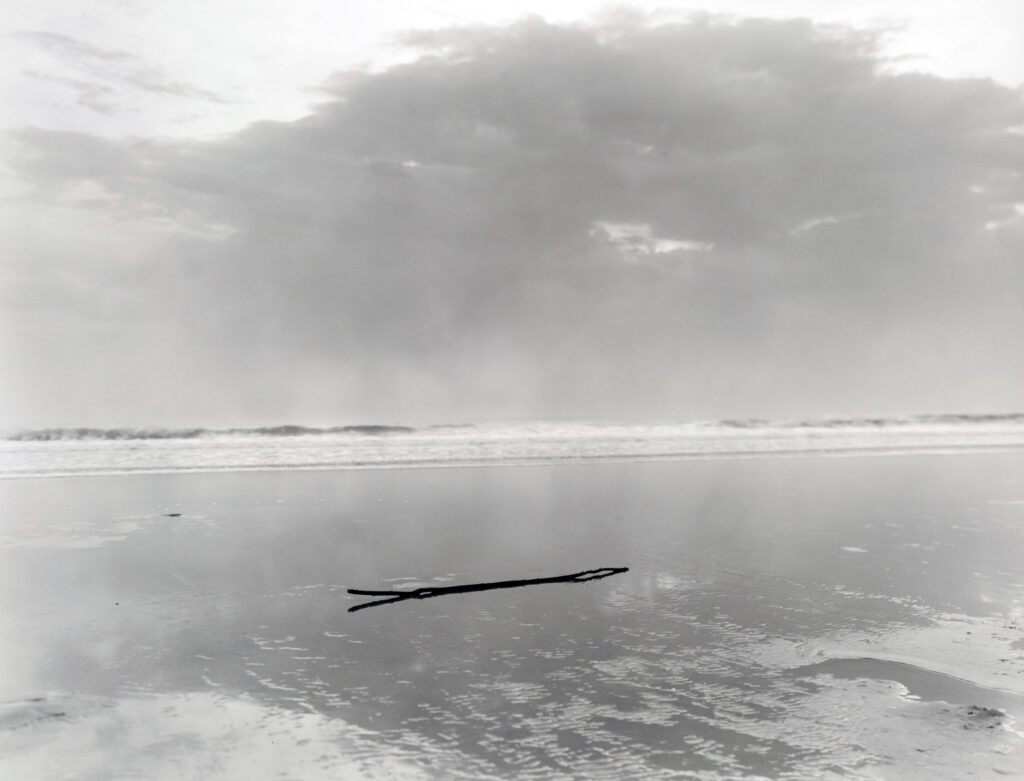
“Baton Perdu, Montalivet, France (1992) by Jock Sturges. The only landscape photograph in The Michael Aaron Gallagher Fine Art Collection by Jock Sturges is this rare 16″ x 20” gelatin silver artist’s proof. Translated from French, “baton perdu” means “lost stick.”
Like all truly great artists, what makes his work particularly relevant is the social debate that has never ceased to surround his art. It is as fervently debated now as it was when he began taking pictures, just as there are still those in the art world who dismiss Jackson Pollock’s drip paintings as a mockery to the profession. Yet, decades later a new crop of artists and visionaries are inspired by the muse that was his work. So how can it be so easily dismissed? Perhaps, the photography of Jock Sturges is simply waiting for a more enlightened generation to understand and value the timeless beauty of his images.
To view more original works in The Michael Aaron Gallagher Fine Art Collection click here. For information about works that have been donated to the collection click here.
